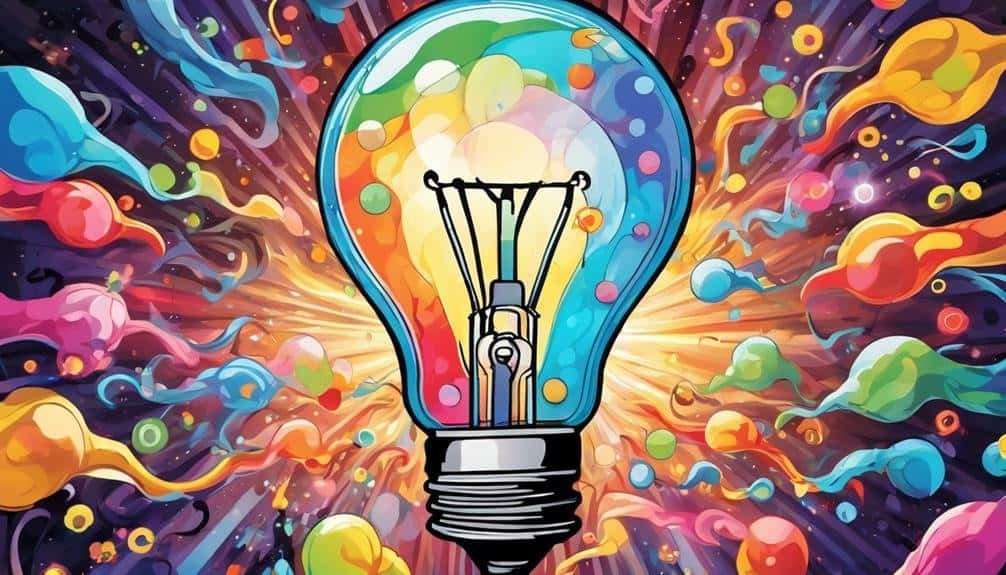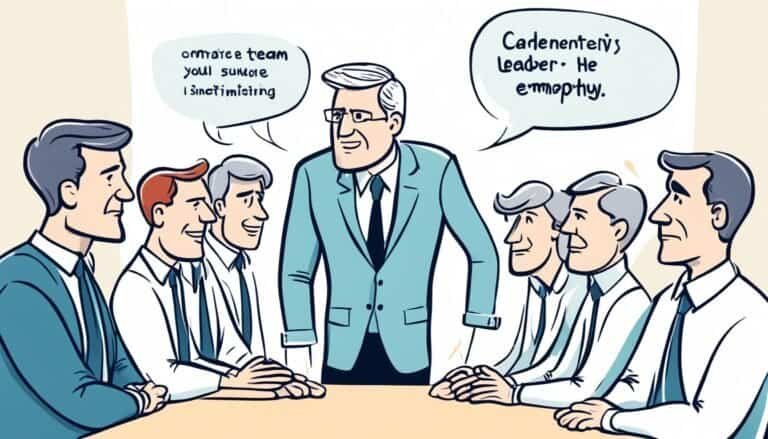What Is Creative Thinking?
Imagine your mind as a vast, uncharted territory waiting to be explored. Creative thinking serves as the compass that guides you through this uncharted landscape, opening doors to innovative solutions and groundbreaking ideas.
As you navigate the kingdom of creativity, you will uncover the essence of what truly fuels inventive thinking and propels you towards uncharted territories of the mind.
Key Takeaways
- Creative thinking involves approaching problems from multiple angles to find innovative solutions.
- Creative thinkers possess characteristics like curiosity, adaptability, resilience, and persistence.
- Creative thinking enhances problem-solving skills in dynamic environments by encouraging experimentation and exploration.
- Tools and strategies like mind mapping, design thinking, and brainstorming sessions can help enhance creativity and foster innovation.
Understanding Creative Thinking
To truly grasp the concept of creative thinking, one must explore into the intricate processes of the human mind and its capacity for innovation. Creative problem solving involves the ability to approach issues from different angles, often thinking beyond the conventional boundaries to devise innovative solutions. It's a cognitive process that requires flexibility, originality, and a willingness to take risks.
When faced with a challenge, creative thinkers exhibit a unique ability to think divergently, generating a myriad of ideas without being constrained by traditional norms. They then converge these ideas to form practical and inventive solutions that may not be immediately obvious to others. This process of divergent and convergent thinking is at the core of creative problem solving.
Creativity isn't a magical gift bestowed upon a select few but a skill that can be nurtured and developed through practice and the exploration of different perspectives. By honing your creative problem-solving skills, you can release a world of innovative solutions that can propel you forward in both your personal and professional endeavors.
Characteristics of Creative Thinkers
Creative thinkers exhibit distinct characteristics that set them apart in their approach to problem solving and innovation. They possess a strong ability for creative problem solving, enabling them to tackle challenges from unique angles. These individuals aren't afraid to explore unconventional ideas and push boundaries to generate innovative solutions.
Creative thinkers display a high level of curiosity, constantly seeking new information and perspectives to fuel their creativity. They're open-minded and adaptable, willing to experiment and embrace change to achieve breakthrough results. Additionally, these individuals demonstrate resilience in the face of setbacks, using failures as learning opportunities to refine their ideas further.
Creative thinkers also exhibit a high degree of persistence, staying committed to their vision even when faced with obstacles. Their willingness to take risks and think outside the box allows them to come up with fresh, inventive solutions that drive progress and inspire others in the process.
Importance of Creative Thinking
Creative thinking plays a pivotal role in enhancing problem-solving skills. It allows individuals to approach challenges from new perspectives and find innovative solutions. By fostering a culture of creative thinking, organizations can drive innovation and growth, staying ahead in competitive markets.
Embracing outside-the-box thinking encourages unconventional ideas that can lead to breakthroughs and advancements in various fields.
Enhancing Problem-Solving Skills
Enhancing problem-solving skills through the application of creative thinking techniques is important today's dynamic and complex environments. Creative solutions and innovative approaches are crucial in tackling the challenges that individuals and organizations face. By utilizing creative thinking, individuals can approach problems from different perspectives, leading to unique and effective solutions.
This process encourages thinking outside the box, fostering a mindset that values experimentation and exploration. Creative problem-solving not only helps in overcoming current obstacles but also equips individuals with the skills needed to navigate future uncertainties.
Embracing creativity in problem-solving enhances adaptability and resilience, enabling individuals to thrive in rapidly changing circumstances. Essentially, honing problem-solving skills through creative thinking empowers individuals to confront challenges with confidence and ingenuity.
Fostering Innovation and Growth
To stimulate innovation and foster growth, the cultivation of creative thinking is paramount in steering today's ever-evolving landscape of challenges and opportunities. Implementing innovation techniques and growth strategies can have a profound impact on organizational success. Here are key points to ponder:
- Encourage Diverse Perspectives: Embrace different viewpoints to spark creativity and innovative solutions.
- Promote a Culture of Experimentation: Encourage risk-taking and learning from failures to drive growth.
- Utilize Design Thinking Methods: Incorporate human-centered approaches to problem-solving for innovative results.
- Embrace Technology Advancements: Leverage emerging technologies to streamline processes and create competitive advantages.
Encouraging Outside-The-Box Thinking
How can fostering a mindset of exploration and experimentation lead to breakthroughs in problem-solving and innovation within organizations? Creative problem solving thrives on outside-the-box brainstorming, encouraging individuals to explore unconventional avenues and challenge traditional thinking. By fostering a culture that values diverse perspectives and novel ideas, organizations can unleash new solutions to complex challenges. This approach not only enhances problem-solving skills but also promotes innovation and growth within the company. Embracing creativity in all aspects of decision-making can set a precedent for continuous improvement and adaptability. Encouraging employees to think creatively empowers them to approach problems from different angles, leading to more effective and innovative outcomes.
| Benefits of Outside-The-Box Thinking | Examples | Impact |
|---|---|---|
| Encourages innovation | Blue-sky thinking | Opens new opportunities |
| Enhances problem-solving skills | Reverse brainstorming | Solves complex issues |
| Fosters creativity and originality | Mind mapping | Inspires unique solutions |
Creative Thinking Vs. Critical Thinking
When comparing Creative Thinking to Critical Thinking, understanding the distinct approaches each type offers is crucial.
Creativity encourages innovative ideas and solutions, while critical thinking emphasizes analysis and evaluation.
Comparison of Thinking Types
In comparing creative thinking with critical thinking, one must examine the distinct approaches each type of thinking employs in problem-solving and decision-making processes. Creative thinking often involves exploring new ideas, generating innovative solutions, and thinking outside the box. On the other hand, critical thinking focuses on analyzing information, evaluating evidence, and making reasoned judgments.
- Creative Thinking
- Emphasizes originality and imagination.
- Encourages risk-taking and experimentation.
- Critical Thinking
- Prioritizes logic and reasoning.
- Requires thorough examination and evaluation of facts.
Understanding the differences between creative and critical thinking can help individuals leverage both approaches effectively in various situations.
Importance of Creativity
Understanding the significance of creativity in the context of both creative and critical thinking is essential for enhancing problem-solving capabilities and fostering innovation. Creative expression is the cornerstone of generating new ideas, while critical thinking helps evaluate and refine those ideas. Together, they form a symbiotic relationship vital for progress.
| Creative Thinking | Critical Thinking | Importance |
|---|---|---|
| Emphasizes originality | Focuses on analysis | Complementary |
| Encourages innovation | Secures logical reasoning | Collaborative |
| Explores possibilities | Examines details | Interconnected |
| Promotes out-of-the-box ideas | Validates solutions | Interdependent |
Benefits of Criticality
Exploring the Benefits of Criticality further in the context of Creative Thinking versus Critical Thinking reveals the distinct advantages each approach offers in problem-solving and decision-making processes.
When comparing problem-solving techniques, Creative Thinking encourages thinking outside the box, fostering innovative solutions. Critical Thinking strategies, on the other hand, emphasize logical reasoning and evidence-based decision-making.
While Creative Thinking promotes idea generation and exploration, Critical Thinking enhances analytical skills and the evaluation of different perspectives. Both approaches complement each other, with Creative Thinking inspiring creativity and imagination, and Critical Thinking providing the necessary framework for systematic analysis and effective problem-solving.
Cultivating a Creative Mindset
By fostering a mindset that welcomes experimentation and embraces uncertainty, you can effectively cultivate your creative abilities. Creative exploration is a pivotal component in developing an innovative mindset. When you engage in creative exploration, you push the boundaries of conventional thinking, allowing new ideas to thrive. This process involves questioning assumptions, seeking alternative perspectives, and being open to diverse possibilities.
To cultivate a creative mindset, it's essential to adopt a growth-oriented approach. Embrace challenges as opportunities for learning and growth rather than obstacles. View failures as stepping stones towards success, recognizing that experimentation often involves setbacks. By reframing failures as valuable learning experiences, you can maintain a positive attitude towards the creative process.
Additionally, practicing mindfulness can enhance your creative abilities. By being fully present in the moment, you can tap into your intuition and unlock your creative potential. Mindfulness enables you to observe your thoughts without judgment, fostering a sense of clarity and openness that's conducive to creative thinking. Incorporating mindfulness practices into your daily routine can help you stay grounded and focused, allowing your creative ideas to flow more freely.
Overcoming Creative Blocks
To overcome creative blocks, identify the root cause of your mental barriers and implement targeted strategies to break through them effectively.
Creative exercises can help you surpass challenges by pushing your mind to think in new ways and explore unconventional ideas. Brainstorming techniques, such as mind mapping or word association, can also aid in unleashing fresh perspectives and fostering creativity.
Finding inspiration from diverse sources like nature, art, or conversations with others can reignite your creative spark and provide new insights. Sometimes, simply taking a break, going for a walk, or engaging in a different activity can clear your mind and allow for innovative ideas to flow more freely.
Tools for Enhancing Creativity
Identifying and utilizing specific tools can tremendously enhance your creative thinking abilities and help you overcome barriers to innovation. Engaging in creative exercises and leveraging innovation techniques are key ways to boost your creativity. Creative exercises such as mind mapping, brainstorming, and visualization can help you generate new ideas and think outside the box. Innovation techniques like design thinking, SCAMPER method, or Six Thinking Hats can provide structured approaches to problem-solving and idea generation. By incorporating these tools into your creative process, you can enhance your ability to come up with innovative solutions and break through mental blocks.
| Creative Exercises | Innovation Techniques |
|---|---|
| Mind Mapping | Design Thinking |
| Brainstorming | SCAMPER Method |
| Visualization | Six Thinking Hats |
Fostering Creativity in the Workplace
To foster creativity in the workplace, you should consider implementing team brainstorming sessions as they encourage collaboration and idea generation.
By encouraging diverse perspectives, you can create an environment that values different viewpoints and promotes innovative thinking.
Providing creative freedom to employees allows them to explore unconventional ideas and solutions, leading to groundbreaking innovations within your organization.
Team Brainstorming Sessions
Brainstorming sessions within a team setting play an important role in fostering creativity and innovation in the workplace. Effective collaboration and understanding group dynamics are essential for maximizing the potential of these sessions. Here are some key points to take into account:
- Encouraging Participation: Make sure that all team members feel comfortable sharing their ideas without fear of judgment.
- Building on Ideas: Use a 'Yes, and…' approach to expand on suggestions and encourage a flow of creativity.
- Setting Clear Goals: Define the objectives of the brainstorming session to keep the team focused and productive.
- Embracing Diversity: Welcome diverse perspectives and experiences to generate a wide range of innovative solutions.
Encouraging Diverse Perspectives
Encouraging diverse perspectives in the workplace is a fundamental strategy for fostering creativity and innovation among team members. Embracing different viewpoints leads to a wider range of ideas and solutions, ultimately driving creative thinking and unique insights. When team members with varied backgrounds, experiences, and expertise collaborate, they bring a multitude of perspectives to the table. This diversity sparks discussions that challenge conventional thoughts, leading to innovative solutions. By valuing and actively seeking out diverse perspectives, organizations can cultivate an environment where creativity flourishes, and new ideas emerge. Embracing diversity not only enhances team dynamics but also propels the generation of fresh and unconventional approaches to problem-solving.
| Benefits of Encouraging Diverse Perspectives |
|---|
| Fosters creative thinking |
| Drives innovative solutions |
| Enhances team collaboration |
Providing Creative Freedom
By granting employees ample creative freedom, organizations can cultivate an environment that nurtures innovation and fosters a culture of creativity in the workplace. Creative exploration becomes more feasible when individuals are given the autonomy to experiment, take risks, and think outside the box.
Unleashing potential is a direct result of this freedom, allowing employees to tap into their unique skills and perspectives to generate fresh ideas. When creative freedom is encouraged, it sparks a sense of ownership and commitment among team members, leading to greater engagement and productivity.
Furthermore, this approach fosters a collaborative spirit, where diverse thoughts converge to produce innovative solutions that drive the organization forward.
The Role of Imagination in Creative Thinking
Imagining vivid scenarios and exploring abstract possibilities play an important role in enhancing creative thinking processes. When you engage in imagination exploration, you open the door to new ideas and innovative solutions. Imagination serves as a playground for your mind, allowing you to break free from conventional thinking patterns and venture into uncharted territories. By delving into the kingdom of imagination, you can challenge existing norms, envision different perspectives, and push the boundaries of what's deemed possible.
In the domain of creativity development, imagination acts as a catalyst for generating unique concepts and original creations. It enables you to visualize outcomes that haven't yet materialized and experiment with unconventional approaches. Through the power of imagination, you can transcend limitations and unveil your full creative potential. Embracing the boundless nature of imagination is key to nurturing a creative mindset and fostering continuous innovation. As you harness the imaginative capabilities of your mind, you pave the way for groundbreaking ideas and transformative breakthroughs.
Embracing Failure as a Path to Innovation
Innovation often emerges from embracing failure as a valuable pathway in the journey of creative development. Embracing failure can be a powerful catalyst for innovation, pushing you to explore new possibilities and think outside the box. Failure isn't the endpoint but a stepping stone towards new discoveries and breakthroughs.
Here are some key points to think about:
- Learning Opportunity: Failure provides invaluable lessons that can guide future endeavors and lead to innovative solutions.
- Risk-Taking: Embracing failure encourages risk-taking, essential for pushing boundaries and uncovering innovative ideas.
- Resilience Building: Overcoming failure nurtures resilience, an important trait in the face of challenges on the path to innovation.
- Iterative Process: Failure drives an iterative process of refinement and improvement, ultimately fostering innovative outcomes.
Conclusion
In the vast garden of ideas, creative thinking is the fertile soil that nurtures innovation to bloom.
Embrace the power of imagination, cultivate a mindset of curiosity, and fearlessly tread the path of failure.
Through the lens of creativity, every challenge becomes a canvas for innovation, every obstacle a stepping stone towards progress.
Let your mind wander freely, for in the domain of creative thinking, the possibilities are endless and the potential for greatness infinite.







